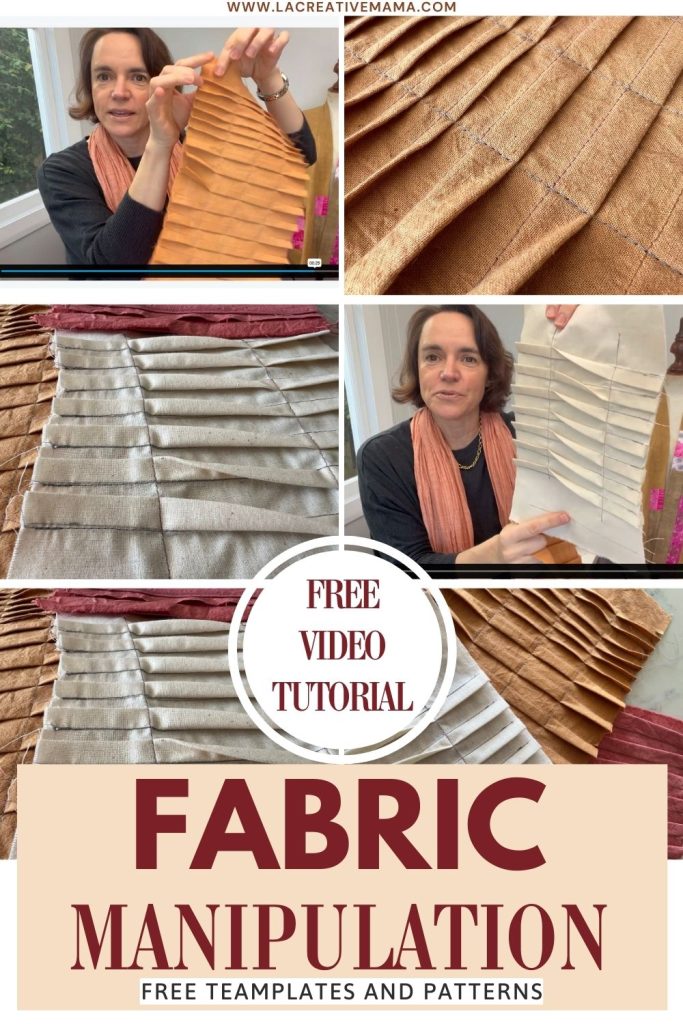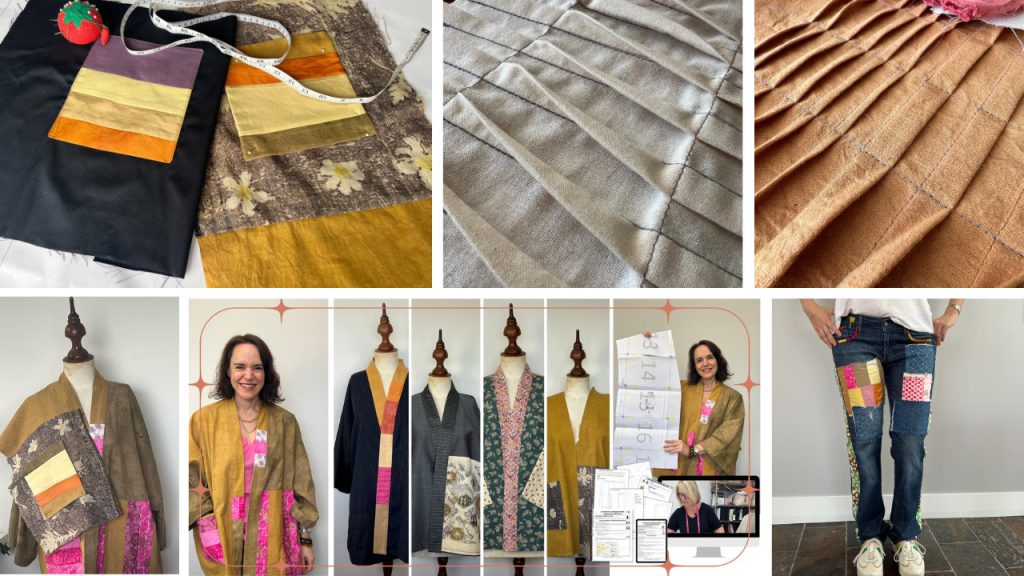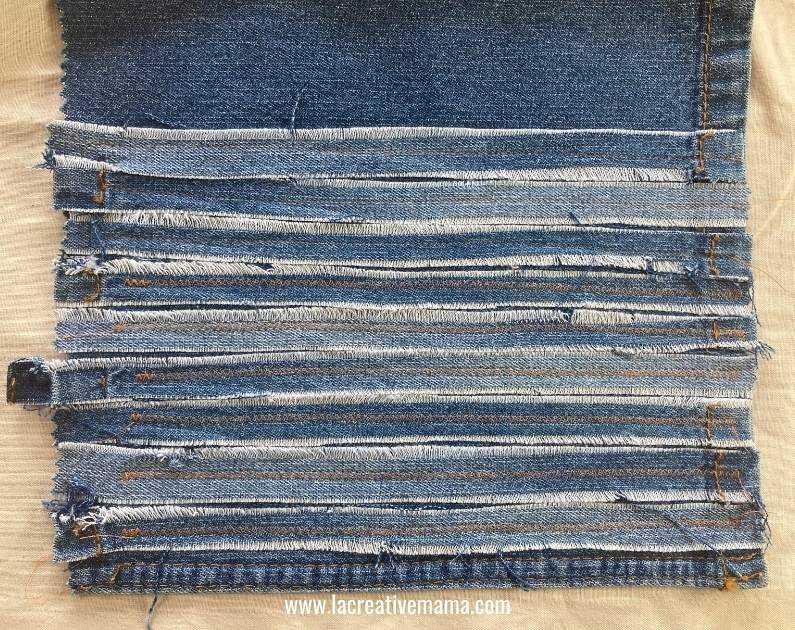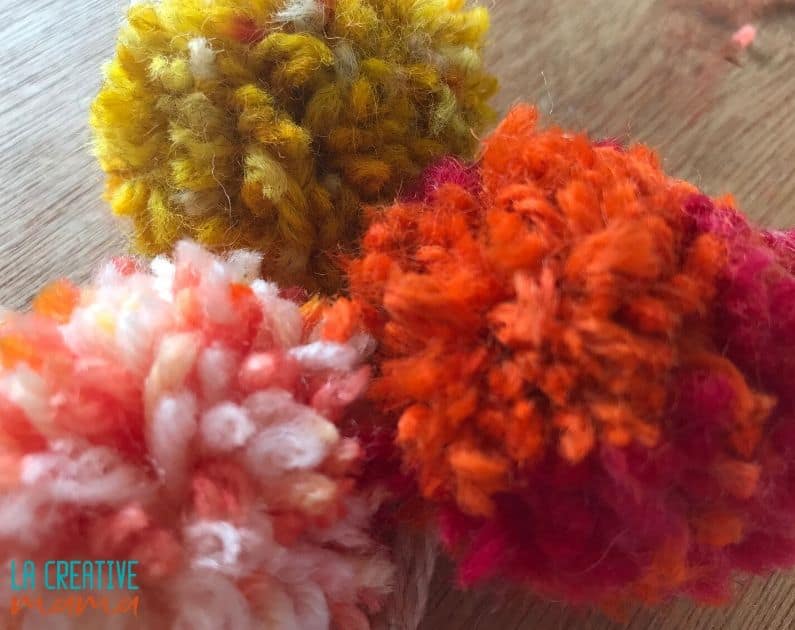Recycle fabric scraps with fabric manipulation
Hi Creative Mamas! I am so excited to share with you the wonderful opportunities available to us to quickly and easily create different textures using fabric manipulation techniques.

Fabric manipulations include different techniques such as textile manipulations as well as all the various techniques included in eco printing and natural dyeing on fabric.
Sign up here for the FREE Fabric Manipulation TRAINING: “How to sew cross over pin tucks”
In this FREE Video Training I walk you through the step by step process to make pin tucks and manipulate them, so that you can design different fabric manipulation effects!
It includes FREE TEMPLATES!

These different fabric manipulation techniques are mostly used in fashion design, interior design, and textile art. It’s also an amazing way to upcycle old clothes and recycle fabric scraps.
You can make unique looking pillows, cushions, throws for your home or to add special details to small handmade gifts.
How to embellish with fabric manipulation
In this post I want to show you techniques that you can use to upcycle old clothes (from your thrift shopping) and embellish pillows, cushions and throws for your home by doing some basic fabric manipulations including how to make ruffles, pin tucks, pleats, shirring etc!
This post contains affiliate links, which means I receive a small commission, at no extra cost to you, if you make a purchase using this link. Please see my disclosure for more details
What is Fabric Manipulation?
In her book “The Art of Manipulating Fabric”, Colette Wolf defines fabric manipulation as ideas about sewing cloth. She describes the sewing process as techniques that change the look and feel of a piece of cloth with the assistance of a threaded needle.
I absolutely love this definition and it’s one that I have worked with throu ghout the years. Once you understand the basics of these techniques you are free to experiment with them and to use them in your own way.
Easy manipulation techniques to get started
Once you learn the basic techniques of these fabric manipulations it is so much fun to experiment with them! Here is a list of my favorite manipulation techniques.
Tucks and Pin Tucks
Tucks are folds in the fabric which are sewn from end to end. Their purpose is to add texture and self thickness to a piece of fabric.
In the photo below you can see how I use tucks and pin tucks to create interesting details using fabric scraps to add to my clothes.

The most common tucks are:
- Pin tucks
- Spaced tucks
- Blind tucks
- Graduated tucks
I love playing with spaced tucks to create interesting textures in pillows and cushions. Here is how I do it using fabric scraps:
1- Make your pattern by drawing straight parallel lines on a piece of paper. At this stage you need to decide the space of the tucks as well as the space in between the tucks. For this demo I have chosen the spaced tucks.

2- Transfer the lines onto your fabric. The easiest way to do this is to mark the notches from the paper pattern and draw the lines with either taylor’s chalk or erasable pen.
I have used a regular pencil to make the lines visible for this tutorial.

3- Pin the tucks in 3 places: top, middle and bottom of the fabric.

4- Sew the tucks using a regular sewing stitch.

5- This step is optional but ads extra texture.
Divide the piece of tucked fabric in even segments and draw horizontal lines to divide the segments. Sew a straight line over your marks.
Turn the fabric around on the opposite direction and sew a line in the middle of each segment so that the tucks are now being directed against the fold.

You will end up with a very textured fabric which is fully tucked.

Pleats
Pleats are measured folds at one end of the fabric. Their purpose is to create volume and movement.
The most common pleats are:
- Box pleats
- Double box pleats
- Knife pleats
- Inverted pleats
Check out the full tutorial on how to make amazing pleats every time!
Gathering
Gathers are folds made at regular intervals in a piece of fabric, which can be pulled to create fullness.
Gathers can be scaled and they can form various patterns and shapes when they are used on the surface of the fabric.
This is an example of how to use gathers to create little flowns around a pillow.
1- Cut strips of fabric scraps. You may have to sew them together to create long strips.

2- Using the longest stitch setting in your sewing machine, sew a straight line on one of the edges of the strip.
Pull one of the threads to create the gather effect. The more you pull the more gathered the fabric will be.

3- Sew the gathers to the base fabric (in this case I am sewing it around a pillow front cover)

This was the end result and it gave a lovely touch to this baby pillow for a new baby girl 🙂 You can read the full tutorial here.

Fabric Yo-Yos
Fabric Yo-Yo’s are shaped pieces of fabric stitched around the edges to form a ball with a knot in the middle.
You will absolutely love these if you enjoy hand sewing. They’re a fun way to add some extra pizazz to an old pair of jeans or to create a piece of fabric by sewing the yo yos together.

Ruffles: how to sew ruffles
Ruffles are pleats or gathers sewn to fabric and drawn up by means of a drawstring. They can be used to add a little extra softness and femininity to clothing. I love using ruffles to upcycle old clothes.
Let me show you how easy these are to make:)
How to make ruffles super quick
1- Choose your fabric scraps and cut a long strip. Sew a straight line through the middle of the strip using the longest stitch setting in you sewing machine.

2- Pull the threads to create a gather. You can gather as much or as little as you want 🙂

3- You will create this ruffled strips of fabric. you can make as many as you want.

4- Place them on top of your base fabric and pin them in place.

5- Sew a regular size stitch line on top of the gathered middle to hold it in place. You can sew one strip next to the other in order to create a beautiful ruffled texture.

Shirring (sewing with elastic thread)
Shirring is a technique that involves the use of elastic thread in the bobbin and it adds elasticity to a non elastic fabric.
The elastic thread runs under the wrong side of the fabric and forms folds in the fabric. It’s a quick and simple way to add fullness and design detail to your work.
This photo shows the effect of the shiring on the right side of the fabric.

This photo shows the underside of the fabric where the elastic bobbin thread creates the gathered effect.

Applique
Appliqué is a technique in which fabric pieces are stitched or sewn to another piece of fabric and then embellished. It’s a great way to upcycle little pieces of fabric scraps into something beautiful.
There are so many ways to applique. My super favorite one is iron on applique work because it’s quick and you can create fun looking templates to personalize your handmade gifts etc.
The photo below shows a beautiful pillow made using an iron fused applique as well as tucks.

Here are some fun applique tutorials:
- How to make a DIY Christmas pillow {super cute}
- How to make a fabric book cover
- How to make a fabric book using upcycled fabric
Patchwork
Patchwork is a piece of fabric sewn or patched onto another piece of fabric. The patch is usually cut from a contrasting material to the rest of the fabric so that it can be seen, adding interest and depth to an overall design.
I love using patchwork to create cushions and pillows using fabric scraps.
The photo below shows an envelope pillow cover made with patchwork technique. The pieces of fabric were all hand dyed using natural dyes.

Quilting
Quilting is a technique in which three layers of fabric (top, middle and bottom) are sewn together to create a padded effect or to give the appearance of a certain pattern.
To get started with quilting you can either use pre made patterns, based on your creativity or you can choose any free motion quilting design that you like.
Quilting is a way to upcycle old clothes or fabrics and use them in your home decor by adding special details to pillows, cushions ,cottons etc!
My favorite quilting technique is quilt as you go, and I also really love the log cabin quilt patchwork pattern. Check out this super easy quilt as you go log cabin quilt tutorial, you will love it!

Check out these fun quilting tutorials:
- How to sew a quilt as you go block with wonky sashing
- How to make a quiet book (Free Patterns)
- Quilted bag pattern – tutorial
Cording
This is a simple way to create beautiful texture and visual interest to your sewing. When you sew corded fabric, the cord warps as it’s sewn through the fabric which creates a lovely pattern on the right side of the cloth.

As you can see from my little sample above, it can also be sewn in between layers of fabric so it’s encased inside stitched tubes of fabric.
You can use it to create beautiful cornices, cushions or just sew them throughout the sewing as you go!
Smocking
Smocking secures the folds of fabric though hand stitching on a piece of cloth. Smocked fabric will have the same thickness as its pleats and will be secured through either decorative stitching or invisible stitches.
There are various types of smocking:
- English smocking
- Direct Smocking
- North American Smocking
- Italian Smocking
The most popular smocking is the one created by using a smocking pleater and then embroidering embroidery stitches on top. The photo below show my little sample of direct smocking (my favorite by far)

Fraying
Fraying is a technique in which loose threads are purposely left on the edges of fabric.
This allows the fabric to break and become fuzzy over time, adding character and softness to it. It’s a great way to give your sewing that broken in look with minimal effort.
A great way of fraying fabric is cutting the fabric and then rip the edges so fraying occurs. The sample below was created by cutting strips of denim and sewing them to another piece of denim. After the strips were sewn I frayed the edges.

Eco Printing
Eco printing on fabric is one of the most satisfying things that I do. It allows me to combine botanical prints from leaves and flowers with different natural fibers such as cotton, linen and silk.

With eco printing, you can get super creative using iron water dips, solar power dips and color blankets.
You can also print your own fabric to make a DIY purse, drawstring bags and crossbody bags.

Download your Eco Printing leaves and flowers FREE list
Shibori
Shibori is a Japanese term for “tied” and it’s a way of dyeing fabrics by folding, twisting, binding or compressing the fabric in order to get different patterns on its surface.

One way to shibori your fabric is using ropes and restricting them around the middle section of the folded piece of cloth so you can get a pattern on the cloth.
Another way is to use rubber bands and applying dye straight onto them instead of dipping the fabric in a pot with dye! Check out this great tutorial on how to tie dye a t-shirt using pink dye.

Fabric dyeing
Fabric dyeing is a way to change the color of your fabric. Depending on what kind of dyes you use, you can either create or enhance patterns and textures on the surface of the cloth.
Natural Dyes are what I use and teach. They are known to be one of the safest and most environment friendly types of dyes.
Chemical Dyes are synthetic dyes created from coal, petroleum and other chemicals that have been known to be toxic for the environment as well as being bad for our health.
Check out the amazing possibilities available to us through natural dyes.

Get your FREE List of the best natural dyes to use!
Hand stitching/embroidery
Hand stitching and embroidery is a form of embellishment that can either add or enhance a pattern on a piece of fabric. There are so many different stitches to use for various purposes.
It’s often used in combination with other techniques such as quilting, smocking, patchwork etc…
Check out these fun embroidery tutorials:
- How to make an embroidered tea cozy
- Embroidery Template for Face Masks
- Hand embroidered pillow that your kids will love

Fabric patches
Fabric patches are great for patching up holes in old clothes or creating unique looking clothing. It’s fantastic to use and recycle old scraps of fabric.
It’s also a fun way of turning your old clothes into something new again! Check out these cool patches that can be used as applique and brooches as well.

Felting
Wool felting is a way of changing the structure of wool by using hot water and agitation. It’s an amazing way to change the appearance of your old clothes by adding felted patches or details.
I love wet felting and I also love combining felting with embroidery. It’s like the best of both worlds!

Adding Lace
Adding lace to your fabric can be done either by hand stitching it to your sewing or by using a sewing machine.
It’s important not to forget the finishing touches when adding lace because it will define how clean or messy your finished piece is. You can use a zigzag stitch with an appropriate width for most types of laces.
Check out this really lovely hair clip holder that I made for my daughter using old pieces of lace 🙂

Pom Poms
Pom poms can be made with different kinds of yarn scraps. They can be sewn on to fabric to finish off pillows, cushions or any other type of sewing!
Check out how you can make fluffy perfect pom poms every time!

Fabric Flowers
Like pom poms, fabric flowers can also be used as a way of embellishing fabrics and adding a unique touch to handmade gifts or pillow covers.

Check out these 2 tutorials on how to make fabric flowers using fabric scraps:
So get creative with these fabric manipulation techniques and make gifts, clothes or home decor!
Save this post to your favorite Pinterest board




Amazing! I sometimes forget that the things we do everyday are manipulations like stitching, darning, cutting and repurposing and colouring. We are all artists, the skill level increasing every time we cut, poke and prod our fabric.
Hi Nancy, you have said it so nicely! Thanks for sharing that lovely way of appreciating our craft. We are makers 🙂